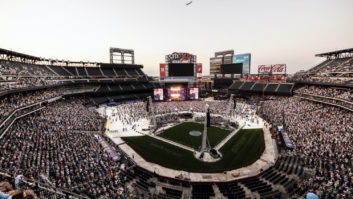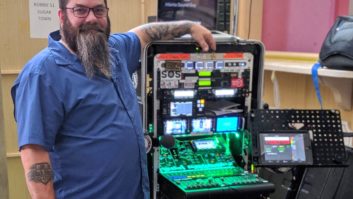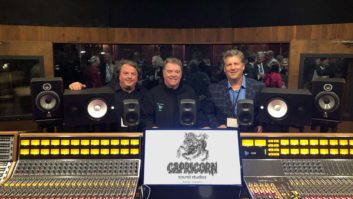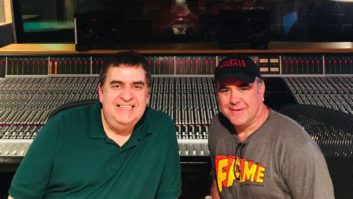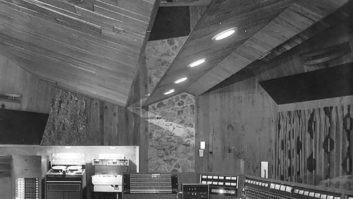The current incarnation of the Allman Brothers Band is unquestionably one of the strongest they’ve put together in their long history; some fans even believe it is comparable to the original lineup that included Duane Allman, Berry Oakley and Dicky Betts. This year marks the 31st anniversary of the group’s seminal release, Live at Fillmore East, and the band, which now consists of Gregg Allman (keyboards and vocals), drummers Jaimoe and Butch Trucks, percussionist Marc Quiñones, bassist Oteil Burbridge, and guitarists Derek Trucks and Warren Haynes, commemorated the anniversary with a three-night stand at Denver’s Fillmore Auditorium in June.
For this tour, the Allman Brothers are using an Electro-Voice X-Array line array system provided by db Sound (Mt. Prospect, Ill.). At the Fillmore, FOH engineer Bruce “Slim” Judd set up two XF long-throw cabinets and two XB double-18 bass cabinets per side, supplemented with two pairs of E-V’s CN compact mid/high speaker. Additionally, the Fillmore setup included two X-Line subs on the floor with a 2×2 XCB compact single-18 bass cabinet on top of each. The system was powered by Electro-Voice P3000 amps, and Judd’s drive rack included a Klark Teknik DN6000 Audio Analyzer, an Al Smart compressor for system compression, an XTA DP226 and two Klark Teknik 3600 stereo equalizers. “You can store 66 memories in those, so if you come back with the same band and P.A., you can call up your EQ and be ready to go,” notes Judd.
Judd controls the whole system with a laptop, a technique that db Sound developed for the Rolling Stones’ Bridges to Babylon tour. “Every amp rack has a stereo three-way crossover,” Judd explains. “The DP226 lets the unit’s 232 connector go to the XTA and an RS485 from there to our drive snake, linking all of the XTAs with a Winbook running Windows XP. We use a wireless computer, using remote-desktop protocol, as the controlling computer, keeping the other on standby. Using this system, we can build our P.A. from the ground up, tailoring it to the room. Craig Laskowski, our systems tech, walks the room during the show listening for trouble spots, and he can clean up any muddiness or problem areas with the remote.”
FOH IS A GAMBLE
Judd, who has been with the band for 13 years and took over FOH mixing a year ago, mixes on a Gamble EX56 console. “We record 48 tracks on six Tascam DA-78HR 24-bit DATs every night. One of the things I can do with the Gamble is go to tape from post-fader so that I keep the mix open. I use a total of 49 inputs for the band, then submix my effects with a little Mackie mixer and send a stereo feed back, leaving me three to four open holes for guests. I do most of my mixing in subgroups, using compressors across the submixes so that I’m not recording the compression.”
Judd keeps effects to a minimum, using a Roland SDE3000 digital delay, an Eventide H3000B Harmonizer, two Lexicon PCM70s and one Lexicon PCM80 reverb. For dynamic control, he uses six dbx 160A compressors, three Drawmer 1960 tube compressors, a TL Audio tube compressor and four Drawmer DS201 gates. Explains Judd, “They play so well that I bring it up and go with what they give me. I don’t use effects much. The only difficulty is that the guitars are a little loud coming off the stage, and we are going for a quieter mix this year. Derek has been playing Washburns lately and the SG a little, and Warren uses Les Pauls and a 335. The sounds are different because of that and the amps. Warren runs a Soldano SLO 100 head and a Diaz CD100 head into an Engl 4×12 cabinet, using a Custom Audio Electronics head switcher to control them. The Soldano is more overdriven, while the Diaz has reverb and is more Fenderish. Derek runs a Marshall 100-watt Super Lead Reissue head into a Randall 4×12 cabinet.”
MIC CHOICES
For all of the vocal mics, Judd picked Shure Beta 57As, which he likes because of their crisp sound and tight pickup pattern. All of the DIs are Countryman. To capture Gregg Allman’s keyboard sounds, Judd takes a stereo feed via a DI from a Roland MKS20 piano module. Allman also plays a Hammond B3 into a Leslie. “We put a Sennheiser 421 on the low Leslie and a left and right Shure SM58 on the high. For [bassist] Oteil, we take a DI feed from the Ampeg speaker output and mike the cabinet with a Beyer M88. Most of the time, that mic only goes to tape. For the guitars, I use a Shure Beta 57 and a Sennheiser 421 on each cabinet.”
Judd mikes Jaimoe’s bass drum with a Beyer M88, snare with a Shure Beta 56, hi-hat with a Shure SM81, a Sennheiser 604 on toms and an AKG 414 on the overheads. Truck’s setup is similar: “I actually put an SM91 inside the bass drum,” says Judd, “and an Electro-Voice RE20 at the front head. I blend the two sounds without using a lot of EQ, which would create phase shift and be difficult to get rid of on tape. The rest of the setup is the same as Jaimoe’s.”
For Quiñones, Judd puts a Shure SM57 on the timbale and bongo, a Beta 57 on congas, an SM58 on cowbells and a Neumann KM184s on the overheads. “With the Neumann, I can pull back on the other mics and let it be a percussion-area mic. The gong has an SM58 low and SM81 high, and the timpani has an RE20 pointing up, with a third of it above the head, which we learned from Tom Dowd. For overhead on the timpani, I use an Audio-Technica 4050.” For guests, there is a spare Randall cabinet with a Randall head miked with an SM57, and Judd keeps a few RE20s, a 451, and SM57s and 58s handy.
Earl McCoy, who has been with the Allmans since 1997, mixes monitors on a Midas XL3. “It’s very road-worthy, has great EQ and has been my favorite monitor console since it came out,” says McCoy, who uses the dbx 480 DriveRack system for EQ and two Yamaha SPX-990s for reverb on the vocals, snare drum and on horn players when they sit in. Effects devices include a Behringer Intelligate and two Behringer Composer stereo compressors. All the wedges are E-V XW15s powered by Crown Micro-Tech models.
MONITOR SUBMIXES
Mixing for the two drummers is complex, explains McCoy. “Butch and Jaimoe have their own consoles. I supply a submix to Butch’s Midas 16-channel and Jaimoe’s Mackie 16-channel mixer. Butch uses headphones instead of monitors and a headphone amp for controlling volume. Jaimoe has a pair of E-V 1122 monitors up on stands next to him, like big headphones,” says McCoy with a laugh. “I use several mix channels for them. Mix five through six is a stereo feed going to Jaimoe with kick, snare, toms one through four, bass, both guitars, keys, the B3, all vocals, timpani and the guest mic if it’s utilized. Mix seven is a bass mix that goes to Butch, and mix nine is Butch’s timpani mix. Mixes 10 through 15 are my submix channels for both drummers. Mix 10 has Butch’s toms that goes to Butch. Mix 11 is all Jaimoe’s drums going to Butch. Mix 12 is the keyboard mix, and mix 13 is vocals, each going to both drummers’ consoles. Mix 14 is a percussion mix, and mix 15 is a subcabinet with kick and a little bit of bass, both for Butch.”
The other mixes are simpler. “Gregg doesn’t like a lot of volume; he has a little kick and snare, his voice and keys. Mix two is the center mix for Warren, an instrument mix with some B3, kick, snare, hat, congas, timbales and bongos. Mix three is Warren’s two outside wedges, which are vocals, panned equally.
“Mix four is Oteil’s, with vocals predominant, keys right underneath, then kick and snare, Derek’s guitar and a little bass. Mix eight is Mark’s, with his vocals, keys, Warren, both congas and the cowbell. He hears everything else onstage because he is high on the riser. Mix 16 is a mix for guest artists. Derek doesn’t use monitors; he doesn’t like to hear anything but his guitar. All of the musicians have a good attitude. They have been at it for so long that they can give me a hand signal to get what they want. They are laid-back and very professional. They don’t make a big scene if they aren’t getting what they want; they call me over, and we discuss it and straighten it out.”
Candace Horgan is a freelance writer based out of the Denver area.

